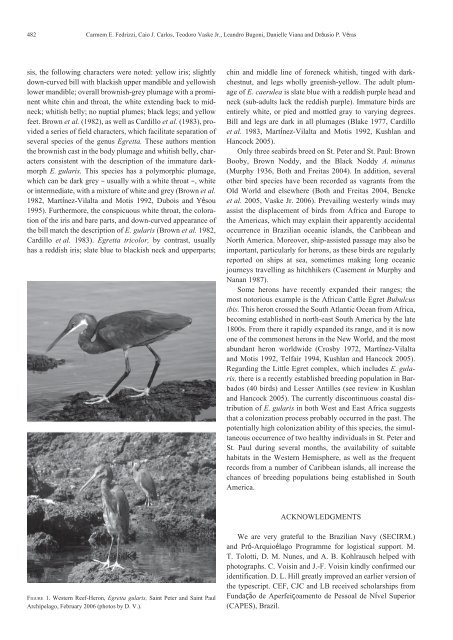Create successful ePaper yourself
Turn your PDF publications into a flip-book with our unique Google optimized e-Paper software.
482 Carmem E. Fedrizzi, Caio J. Carlos, Teodoro Vaske Jr., Leandro Bugoni, Danielle Viana and Dráusio P. Véras<br />
sis, the following characters were noted: yellow iris; slightly<br />
down‑curved bill with blackish upper mandible and yellowish<br />
lower mandible; overall brownish‑grey plumage with a promi‑<br />
nent white chin and throat, the white extending back to mid‑<br />
neck; whitish belly; no nuptial plumes; black legs; and yellow<br />
feet. Brown et al. (1982), as well as Cardillo et al. (1983), pro‑<br />
vided a series of field characters, which facilitate separation of<br />
several species of the genus Egretta. These authors mention<br />
the brownish cast in the body plumage and whitish belly, char‑<br />
acters consistent with the description of the immature <strong>da</strong>rk‑<br />
morph E. gularis. This species has a polymorphic plumage,<br />
which can be <strong>da</strong>rk grey – usually with a white throat –, white<br />
or intermediate, with a mixture of white and grey (Brown et al.<br />
1982, Martínez‑Vilalta and Motis 1992, Dubois and Yésou<br />
1995). Furthermore, the conspicuous white throat, the colora‑<br />
tion of the iris and bare parts, and down‑curved appearance of<br />
the bill match the description of E. gularis (Brown et al. 1982,<br />
Cardillo et al. 1983). Egretta tricolor, by contrast, usually<br />
has a reddish iris; slate blue to blackish neck and upperparts;<br />
FiguRe 1. Western Reef‑Heron, Egretta gularis, Saint Peter and Saint Paul<br />
Archipelago, February 2006 (photos by D. V.).<br />
chin and middle line of foreneck whitish, tinged with <strong>da</strong>rk‑<br />
chestnut, and legs wholly greenish‑yellow. The adult plum‑<br />
age of E. caerulea is slate blue with a reddish purple head and<br />
neck (sub‑adults lack the reddish purple). Immature birds are<br />
entirely white, or pied and mottled gray to varying degrees.<br />
Bill and legs are <strong>da</strong>rk in all plumages (Blake 1977, Cardillo<br />
et al. 1983, Martínez‑Vilalta and Motis 1992, Kushlan and<br />
Hancock 2005).<br />
Only three seabirds breed on St. Peter and St. Paul: Brown<br />
Booby, Brown Noddy, and the Black Noddy A. minutus<br />
(Murphy 1936, Both and Freitas 2004). In addition, several<br />
other bird species have been recorded as vagrants from the<br />
Old World and elsewhere (Both and Freitas 2004, Bencke<br />
et al. 2005, Vaske Jr. 2006). Prevailing westerly winds may<br />
assist the displacement of birds from Africa and Europe to<br />
the Americas, which may explain their apparently accidental<br />
occurrence in Brazilian oceanic islands, the Caribbean and<br />
North America. Moreover, ship‑assisted passage may also be<br />
important, particularly for herons, as these birds are regularly<br />
reported on ships at sea, sometimes making long oceanic<br />
journeys travelling as hitchhikers (Casement in Murphy and<br />
Nanan 1987).<br />
Some herons have recently expanded their ranges; the<br />
most notorious example is the African Cattle Egret Bubulcus<br />
ibis. This heron crossed the South Atlantic Ocean from Africa,<br />
becoming established in north‑east South America by the late<br />
1800s. From there it rapidly expanded its range, and it is now<br />
one of the commonest herons in the New World, and the most<br />
abun<strong>da</strong>nt heron worldwide (Crosby 1972, Martínez‑Vilalta<br />
and Motis 1992, Telfair 1994, Kushlan and Hancock 2005).<br />
Regarding the Little Egret complex, which includes E. gularis,<br />
there is a recently established breeding population in Bar‑<br />
bados (40 birds) and Lesser Antilles (see review in Kushlan<br />
and Hancock 2005). The currently discontinuous coastal dis‑<br />
tribution of E. gularis in both West and East Africa suggests<br />
that a colonization process probably occurred in the past. The<br />
potentially high colonization ability of this species, the simul‑<br />
taneous occurrence of two healthy individuals in St. Peter and<br />
St. Paul during several months, the availability of suitable<br />
habitats in the Western Hemisphere, as well as the frequent<br />
records from a number of Caribbean islands, all increase the<br />
chances of breeding populations being established in South<br />
America.<br />
ACKNOWLEDGMENTS<br />
We are very grateful to the Brazilian Navy (SECIRM.)<br />
and Pró‑Arquioélago Programme for logistical support. M.<br />
T. Tolotti, D. M. Nunes, and A. B. Kohlrausch helped with<br />
photographs. C. Voisin and J.‑F. Voisin kindly confirmed our<br />
identification. D. L. Hill greatly improved an earlier version of<br />
the typescript. CEF, CJC and LB received scholarships from<br />
Fun<strong>da</strong>ção de Aperfeiçoamento de Pessoal de Nível Superior<br />
(CAPES), Brazil.

















